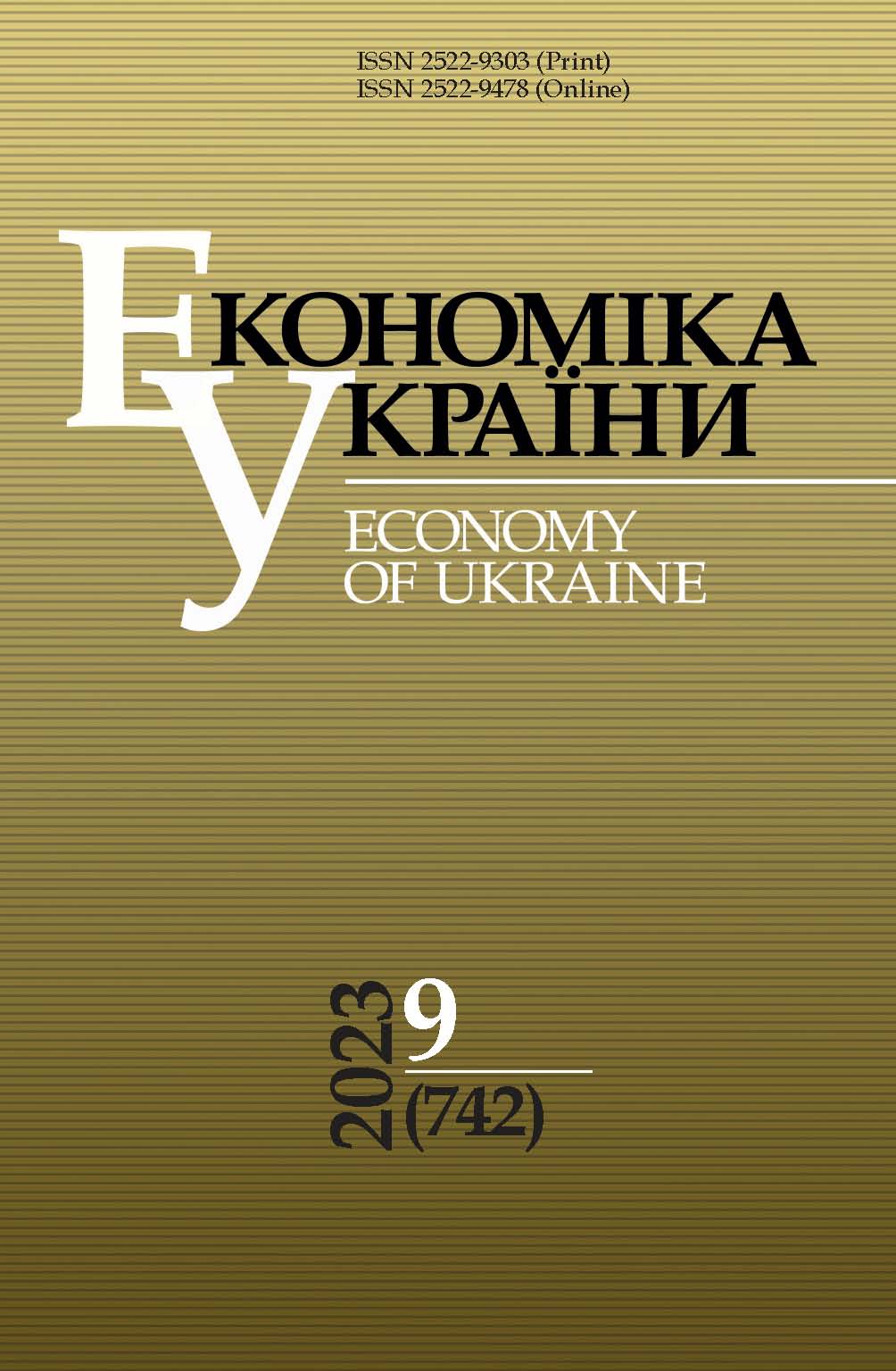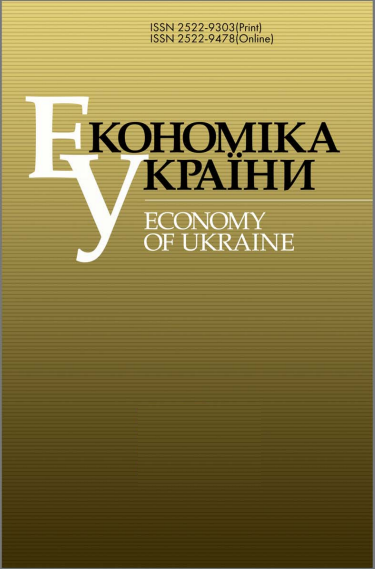WARPED FINANCING MODELS AS ADJUSTMENTS TO THE DISTORTED INSTITUTIONAL ENVIRONMENT
DOI:
https://doi.org/10.15407/economyukr.2023.09.055Keywords:
institutional environment; institutional development; zombie enterprises; quasi-risk financing model; negative equityAbstract
The influence of institutional development on economic phenomena within the country, in particular on market entry strategies and functioning of enterprises, are studied. It is established that as the institutional environment develops, the focus of their activity shifts from attempts to use distortions in the institutional environment to their advantage (optimization of taxation and obtaining monopoly profits) to more competitive behavior (technical and marketing innovations).
Zombie enterprises are considered as an example of the enterprise functioning strategy based on the use of distortions in the institutional environment to one's advantage (a high level of concentration and oligopolization of the economy along with the government policy of lending promotion). The negative impact a high concentration of zombie enterprises has on the country's economy is shown, the existing approaches to their definition and approximately normal prevalence are considered.
The Ukrainian variety of zombie enterprises - enterprises with quasi-risk and fraudulent financing models - is studied. The distortions in Ukraine’s institutional environment, which made possible the functioning of enterprises with quasi-risk and fraudulent financing models, are characterized. In particular, those are the unpredictability and high cost of legal proceedings, which make the initiation of bankruptcy process from the position of a small creditor almost impossible; a significant gap in the protection of the rights between large and small business entities; the inherited common production cycle for a significant number of industrial enterprises and their inability to go beyond it in search of both sales markets and counterparties.
The characteristics of enterprises with quasi-risk and fraudulent financing models are given (stable negative equity while maintaining profitable operating activities, the presence of payables that are overdue for 60 days or more). The approximate level of prevalence of these financing models, which is characterized by the growth of the aggregate sectoral share of uncovered liabilities, is outlined.
References
Bangura Y. Economic restructuring, coping strategies and social change: implications for institutional development in Africa. Development and change, 1994, Vol. 25, Iss. 4, pp. 785-827.
doi.org/10.1111/j.1467-7660.1994.tb00536.x
Hermelo F.D., Vassolo R. Institutional development and hypercompetition in emerging economies. Strategic Management Journal, 2010, Vol. 31, No. 13, pp. 1457-1473. URL: www.jstor.org/stable/40961192
doi.org/10.1002/smj.898
Bevan A., Estrin S., Meyer K. Foreign investment location and institutional development in transitional economies. International Business Review, 2004, Vol. 13, Iss. 1, pp. 43-64. URL: www.sciencedirect.com/science/article/abs/pii/S0969593103001082
doi.org/10.1016/j.ibusrev.2003.05.005
Wu Jie. Marketing capabilities, institutional development, and the performance of emerging market firms: a multinational study. International Journal of Research in Marketing, 2013, Vol. 30, Iss. 1, pp. 36-45.
doi.org/10.1016/j.ijresmar.2012.07.001
Liu Yulong, Yu Yang. Institutions, firm resources and the foreign establishment mode choices of Chinese firms: the moderating role of home regional institutional development. Journal of Business Research, 2018, Vol. 93(C), pp. 111-121.
doi.org/10.1016/j.jbusres.2018.04.026
Hoshi T. Naze Nihon wa Ryu do sei no Wana kara Nogarerareainoka? (Why is the Japanese Economy Unable to Get Out of a Liquidity Trap?). In: Zero Kinri to Nihon Keizai (Zero Interest Rate and the Japanese Economy). Mitsuhiro Fukao, Hiroshi Yoshikawa (Eds.). Tokyo, Nihon Keizai Shimbunsha, 2000, pp. 233-266.
Caballero R.J., Hoshi T., Kashyap A.K. Zombie Lending and Depressed Restructuring in Japan. American Economic Review, 2008, Vol. 98, No. 5, pp. 1943-1977.
doi.org/10.1257/aer.98.5.1943
Hosono Kaoru, Masaya Sakuragawa. Soft Budget Problems in the Japanese Credit Market. Nagoya City University Discussion Papers in Economics, 2003, No. 345. URL: web.econ.keio.ac.jp/staff/masaya/dl/forthcomingpaper/sbc.pdf
Joe P., Rosengren E.S. Unnatural Selection: Perverse Incentives and the Misallocation of Credit in Japan. American Economic Review, 2005, Vol. 95, No. 4, pp. 1144-1166. URL: www.jstor.org/stable/4132709
doi.org/10.1257/0002828054825691
McGowan M.A., Andrews D., Millot V. The walking dead? Zombie firms and productivity performance in OECD countries. OECD Economics Department Working Papers, 2017, No. 1372. URL: read.oecd-ilibrary.org/economics/the-walking-dead_180d80ad-en#page1
Banerjee R.N., Hoffman B. The rise of zombie firms: causes and consequences. BIS Quarterly review, 2018, pp. 67-78. URL: www.bis.org/publ/qtrpdf/r_qt1809g.htm
Kerimov P., Zymovets V. Quasi-Risk and Fraudulent Financing Models: The Case of Firms with Negative Equity in Ukraine. Economic Studies Journal, 2021, Iss. 8, pp. 48-68. URL: ideas.repec.org/a/bas/econst/y2021i8p48-68.html
Ang T.C. Are firms with negative book equity in financial distress? Review of Pacific Basin Financial Markets and Policies, 2015, Vol. 18, No. 03, pp. 1-41.
doi.org/10.1142/S0219091515500162
Downloads
Published
How to Cite
Issue
Section
License
Copyright (c) 2023 Economy of Ukraine

This work is licensed under a Creative Commons Attribution-NonCommercial-NoDerivatives 4.0 International License.



